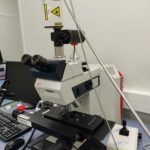A Raman/microscopy equipment for radiobiology
Santiago Sanchez Salas, a 4th year engineering student at INSA Toulouse, has developed a coupler system allowing to consider cellular observations at the micrometer scale with excellent signal-to-noise intensity and resolution.
Santiago Sanchez Salas arrived in Nantes in early June 2021 for an engineering internship in physics co-supervised by Guillaume Blain (Subatech lab, Radiochemistry team) and Nicolas Varmenot (CRCINA, nuclear oncology team) and funded by IRC TransForMed. His mission: to develop a coupling system between a fluorescence optical microscope and a Raman spectroscopy device to facilitate the observation of cellular compounds before and after irradiation.

“The team had already done some setups with a simple lens as objective, but the resulting spectra were not good enough”, explains the young man. The engineering student also made several attempts during his 4-month internship to develop a high-performance coupler system. Bet won since his final assembly significantly improves the signal-to-noise intensity (x10), as well as the image resolution. “Santiago’s work has made it possible to reproduce the same results as a reference publication from 2016, and even go beyond,” Guillaume Blain is pleased to say.
A great achievement, which the intern is enjoying: “The project and the team were very inspiring and I am proud to have been able to finish and deliver before leaving. I was surprised by my abilities.” What will he do after his fifth and final year of school? “Medical physics, I hope. I liked research but I don’t want to go into a thesis. Except maybe a thesis in a company.”

